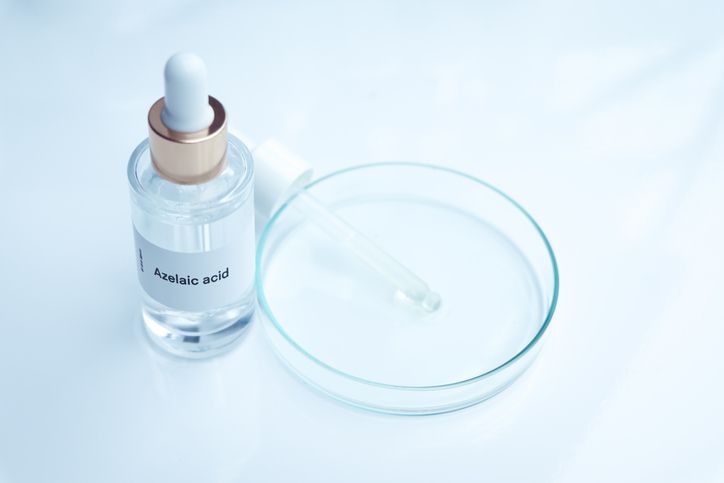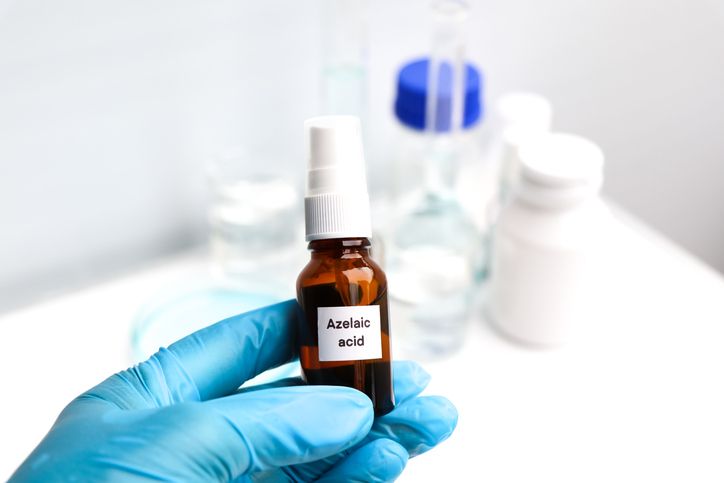- Home
- Trend
- Weight Loss Strategies
- Acne Tips
- Hair Health Information
- Blemish Removal Tips
- Acne Scar Removal Tips
- Muscle Building Techniques
- Intimate Care Tips
- Postpartum Intimate Care
- Eye Bags Wiki
- Tips for Face Slimming
- Secret of Permanent Hair Removal
- Breast Enlargement Tips
- Cure to Snoring
- Marionette Lines
- Skin-Tightening Secrets
Azelaic acid is a familiar name for those with acne-prone skin. Celebrated as a gem in acne treatment, it has long been used to combat pimples and various skin concerns. However, most people only know that it helps with acne, without truly understanding how it works. In this article, we’ll explore the science behind azelaic acid, explaining its multiple benefits in skincare. Whether you have pimples or stubborn acne, understanding what azelaic acid can do for your skin will help you tackle skin issues more effectively and achieve a healthier complexion!
What is Azelaic Acid? It Has Nothing to Do with Azaleas!

Azelaic acid is a naturally occurring dicarboxylic acid usually produced through yeast fermentation or chemical synthesis. However, many people mistake it for being derived from the azalea flower because the English names are similar. There’s even a widespread misconception that azelaic acid is extracted from azalea roots. This misunderstanding has made “azelaic acid” a popular but misleading name—one that’s not actually connected to the plant at all.
Azelaic acid is an organic compound made of a nine-carbon chain. It occurs naturally in grains like rye, barley, and wheat. It’s also produced on human skin by Malassezia furfur, a common yeast that breaks down oleic acid into azelaic acid, leading to azelaic acid levels of about 20–80 ng/mL in human plasma. In plants, azelaic acid serves as a “signaling molecule” that helps trigger defense responses when under threat.
That said, industrial production of azelaic acid typically involves oxidative cleavage or ozonolysis of oleic acid, rather than relying on the slow breakdown process by yeast. These methods are more efficient and suitable for large-scale commercial production.
Azelaic acid isn’t just a plant signaling molecule—it has wide-ranging uses in dermatology. It’s commonly used to treat acne, lighten pigmentation, and reduce blemishes. While it’s most often found in topical creams, it’s also added to some skincare products. There is even research suggesting it might inhibit 5-alpha reductase, potentially helping treat male-pattern baldness, though this has not yet been confirmed through clinical trials.
Azelaic Acid – A Skincare Treasure with 6 Hidden Treatment Benefits!

Pimples and acne usually result from several factors: clogged pores due to excess keratin buildup, overproduction of sebum, and bacterial inflammation. Azelaic acid, being a mild acid (even weaker than acetic acid), provides multiple skincare benefits—particularly for acne and pigmentation. Here are six scientifically backed treatment functions:
1. Exfoliates and Treats Acne & Pimples
A 2016 study found that using azelaic acid for 12 weeks helped improve mild to moderate acne on both the face and body, and even enhanced patients’ quality of life. Its exfoliating action helps reduce follicular blockage, a key factor in acne formation.
Many turn to topical retinoic acid (AHA), salicylic acid (BHA), and fruit acids like glycolic and mandelic acid to treat clogged pores. These acids, especially AHAs, are water-soluble and used for exfoliation. However, alternating azelaic acid with other acids (if your skin tolerates it) can be very effective. Just be cautious if you have sensitive skin, as combining acids can cause irritation.
2. Brightens Skin and Fades Pigmentation
Azelaic acid is also a powerful skin brightener! It acts as a competitive inhibitor of tyrosinase, an enzyme involved in melanin production, and also reduces free radical formation and mitochondrial enzyme activity. It’s particularly effective against abnormal pigmentation, like melasma and post-inflammatory marks, while minimally affecting normal melanin cells.
For instance, the yeast that causes tinea versicolor produces azelaic acid, which inhibits melanin production and causes white spots on the skin. This led researchers to explore azelaic acid as a skin-lightening agent. Studies show 20% azelaic acid can outperform 4% hydroquinone in lightening pigmentation—without the latter’s side effects like ochronosis, allergies, or potential carcinogenicity.
3. Anti-Inflammatory Properties
Azelaic acid reduces inflammation by inhibiting oxidative metabolism in cells and scavenging reactive oxygen species (ROS) such as O₂⁻, OH·, and H₂O₂. This makes it useful for treating acne and rosacea.
Common topical treatments for rosacea include brimonidine for redness, and anti-inflammatory agents like ivermectin, metronidazole, or azelaic acid.
4. Antibacterial Action
Azelaic acid can inhibit the growth of acne-causing Propionibacterium acnes and Staphylococcus epidermidis by interfering with their protein synthesis. Its antibacterial effect is stronger at higher concentrations and lower pH levels.
5. Antifungal Effects
Studies show that azelaic acid inhibits various fungi at pH levels between 4.8 and 5.5. This includes dermatophytes, Scopulariopsis brevicaulis, Pityrosporum ovale, and Candida glabrata.
6. Supports Treatment of Malignant Melanoma
Due to its ability to inhibit melanin production, 20% topical azelaic acid has been explored as an adjunct therapy for lentigo maligna melanoma. However, it’s not recommended as a primary treatment—only as a supplementary option.
免費體驗
Acne Treatment
1 Minute Self-Registration
Date should not be before minimal date
Comparing Popular Acids: Azelaic Acid vs. Retinoic Acid vs. Mandelic Acid
Other commonly used acids in skincare include retinoic acid and mandelic acid. Here’s a side-by-side comparison of their key features:
| Acid | Strength | Possible Reactions | Usage Notes |
|---|---|---|---|
| Azelaic Acid | Mild | Dryness, mild burning, itching | Safe for use during pregnancy (consult doctor). Doesn’t increase photosensitivity—can be used during the day. |
| Retinoic Acid (A Acid) | Strong | Dryness, redness, potential purging in early use | Not suitable for pregnant women. Avoid sun exposure. |
| Mandelic Acid | Mild | Dryness, peeling, possible purging | Can be used during pregnancy with medical advice. Avoid sun for one week post-use; apply physical sunscreen when going out. Pause use on broken skin. |
Each acid has its own strengths and target users. Consult a dermatologist to choose the most suitable product for your skin type and condition.
Free Medical Aesthetic Trial! A Must-Try Acne Treatment for Acne-Prone Skin!
If you're struggling with serious acne and blemishes, I highly recommend professional aesthetic treatments. Personally, I had a great experience with Perfect Medical’s Acne Treatment a few months ago—it resolved my sensitive and acne-prone skin issues and gave me a confidence boost!
This non-invasive treatment uses gentle vacuum microdermabrasion to remove deep-seated oil, dirt, and dead skin cells. At the same time, medical-grade serums are infused into the skin to stimulate collagen repair and purify the skin from within. It targets acne, acne scars, enlarged pores, excess oil, and blackheads—while also eliminating acne-causing bacteria at the root to prevent recurrence.
Best of all, your first treatment is free! This offer applies not only to the Acne Treatment but to all treatments at Perfect Medical. Click the link below to register and book your free trial session:
Experience Now: Perfect Medical Acne Treatment免費體驗
Acne Treatment
1 Minute Self-Registration
Date should not be before minimal date
FAQ

Does azelaic acid cause any side effects?
Like other acid-based skincare products, azelaic acid can lead to some side effects. The most commonly reported reactions include a burning sensation in about 16% of users, mild redness or swelling in up to 16%, skin irritation or localized redness in up to 2%, and slight peeling in around 1% of cases. These symptoms are usually temporary and tend to subside within an hour. With consistent use, the skin typically improves over time—most people begin to see results after about one month, though this varies from person to person. Overall, azelaic acid is considered quite safe for most individuals. However, if side effects persist or seem to be worsening, it’s important to consult a dermatologist. Bringing the product with you to your appointment can help the doctor better assess your situation.
How can azelaic acid be used safely?
Although azelaic acid is generally low-risk, it is still a medicinal product and should ideally be used under the guidance of a doctor or pharmacist to ensure safe application. It is typically recommended to apply azelaic acid once in the morning and once in the evening after cleansing with a gentle face wash. The product should be applied directly to areas affected by acne, blemishes, dark spots, or hyperpigmentation. However, those with sensitive skin may want to start with once-daily application and monitor how their skin reacts. If no severe irritation occurs, usage can gradually be increased to twice daily. Since azelaic acid may cause dryness or peeling in some users, applying a basic, fragrance-free moisturizer afterward can help prevent over-drying and reduce irritation. Should persistent dryness, itching, or other discomfort arise, it’s best to stop using acid-based products and seek professional dermatological advice.
Are there any ingredients or products that should not be used with azelaic acid?
While using azelaic acid, it's advisable to avoid harsh cleansers or products that contain oil-control or astringent ingredients. If you're looking to enhance the effectiveness of azelaic acid, you might consider pairing it with hyaluronic acid treatments or a simple, non-comedogenic moisturizer. Both are gentle on the skin—especially hyaluronic acid, which has a high water content and can help soothe any potential irritation caused by azelaic acid, making the overall experience more comfortable for your skin.
Do I need to be extra careful with sun protection while using azelaic acid?
Azelaic acid itself does not cause photosensitivity. However, because it helps reduce skin keratinization, it can make your skin more vulnerable to sun damage, increasing the risk of tanning or sunburn. For this reason, it's especially important to apply adequate sun protection while using azelaic acid.
Which is better: azelaic acid or retinoic acid (vitamin A acid)?
There is a common misconception that azelaic acid is always superior to topical retinoic acid, or that retinoic acid is necessarily harsh and undesirable. In reality, when it comes to treating acne and breakouts, azelaic acid is not as potent as retinoic acid. Azelaic acid also doesn't perform as well in anti-inflammatory action compared to benzoyl peroxide, nor does it match the infection-fighting power of topical antibiotics. While azelaic acid is known for its broad range of effects and gentle nature, its efficacy is slightly weaker than that of retinoic acid.









